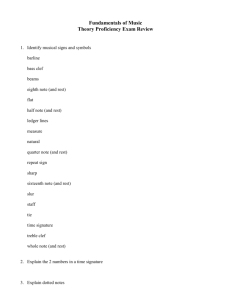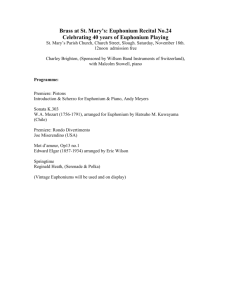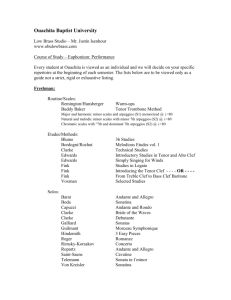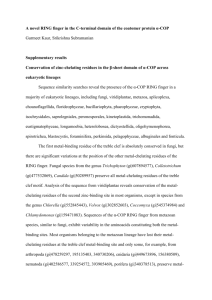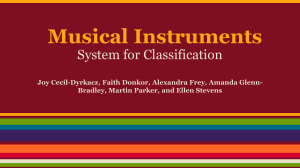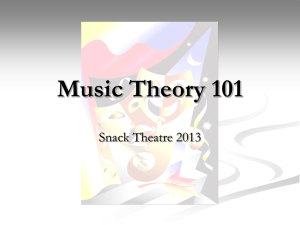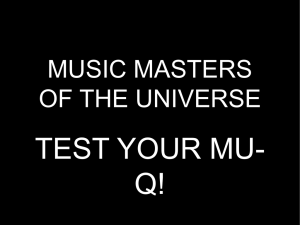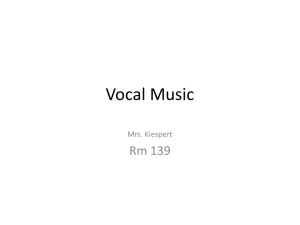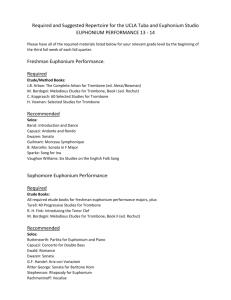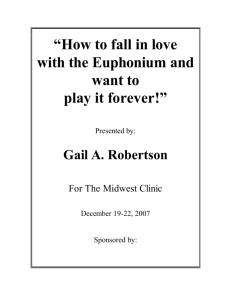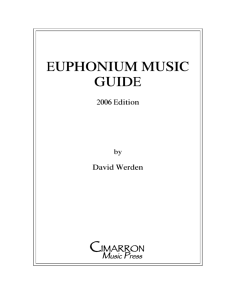Baritone and Euphonium GRADE 7
advertisement
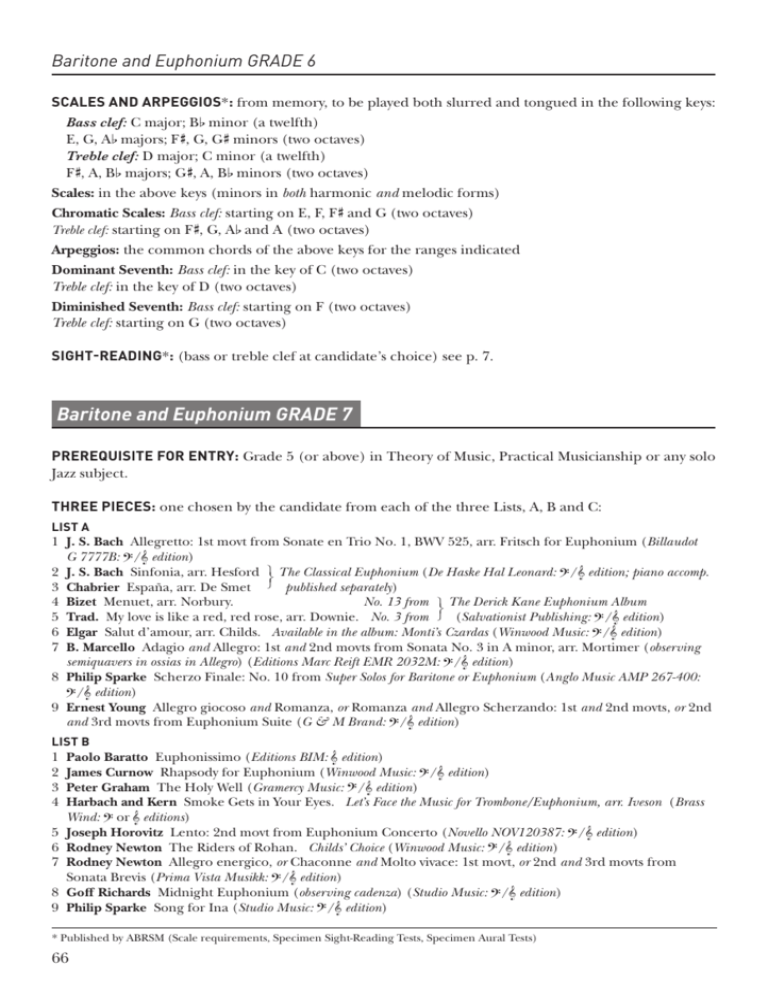
Baritone and Euphonium GRADE 6 SCALES AND ARPEGGIOS*: from memory, to be played both slurred and tongued in the following keys: Bass clef: C major; B b minor (a twelfth) E, G, A b majors; F #, G, G # minors (two octaves) Treble clef: D major; C minor (a twelfth) F #, A, B b majors; G #, A, B b minors (two octaves) Scales: in the above keys (minors in both harmonic and melodic forms) Chromatic Scales: Bass clef: starting on E, F, F # and G (two octaves) Treble clef: starting on F #, G, A b and A (two octaves) Arpeggios: the common chords of the above keys for the ranges indicated Dominant Seventh: Bass clef: in the key of C (two octaves) Treble clef: in the key of D (two octaves) Diminished Seventh: Bass clef: starting on F (two octaves) Treble clef: starting on G (two octaves) SIGHT-READING*: (bass or treble clef at candidate’s choice) see p. 7. Baritone and Euphonium GRADE 7 PREREQUISITE FOR ENTRY: Grade 5 (or above) in Theory of Music, Practical Musicianship or any solo Jazz subject. THREE PIECES: one chosen by the candidate from each of the three Lists, A, B and C: LIST A 1 J. S. Bach Allegretto: 1st movt from Sonate en Trio No. 1, BWV 525, arr. Fritsch for Euphonium (Billaudot G 7777B: ? /& edition) 2 J. S. Bach Sinfonia, arr. Hesford ¸ The Classical Euphonium (De Haske Hal Leonard: ? /& edition; piano accomp. ˝ 3 Chabrier España, arr. De Smet ˛ published separately) 4 Bizet Menuet, arr. Norbury. No. 13 from ¸ The Derick Kane Euphonium Album ˝ 5 Trad. My love is like a red, red rose, arr. Downie. No. 3 from ˛ (Salvationist Publishing: ? /& edition) 6 Elgar Salut d’amour, arr. Childs. Available in the album: Monti’s Czardas (Winwood Music: ? /& edition) 7 B. Marcello Adagio and Allegro: 1st and 2nd movts from Sonata No. 3 in A minor, arr. Mortimer (observing semiquavers in ossias in Allegro) (Editions Marc Reift EMR 2032M: ? /& edition) 8 Philip Sparke Scherzo Finale: No. 10 from Super Solos for Baritone or Euphonium (Anglo Music AMP 267-400: ? /& edition) 9 Ernest Young Allegro giocoso and Romanza, or Romanza and Allegro Scherzando: 1st and 2nd movts, or 2nd and 3rd movts from Euphonium Suite (G & M Brand: ? /& edition) LIST B 1 Paolo Baratto Euphonissimo (Editions BIM: & edition) 2 James Curnow Rhapsody for Euphonium (Winwood Music: ? /& edition) 3 Peter Graham The Holy Well (Gramercy Music: ? /& edition) 4 Harbach and Kern Smoke Gets in Your Eyes. Let’s Face the Music for Trombone/Euphonium, arr. Iveson (Brass Wind: ? or & editions) 5 Joseph Horovitz Lento: 2nd movt from Euphonium Concerto (Novello NOV120387: ? /& edition) 6 Rodney Newton The Riders of Rohan. Childs’ Choice (Winwood Music: ? /& edition) 7 Rodney Newton Allegro energico, or Chaconne and Molto vivace: 1st movt, or 2nd and 3rd movts from Sonata Brevis (Prima Vista Musikk: ? /& edition) 8 Goff Richards Midnight Euphonium (observing cadenza) (Studio Music: ? /& edition) 9 Philip Sparke Song for Ina (Studio Music: ? /& edition) * Published by ABRSM (Scale requirements, Specimen Sight-Reading Tests, Specimen Aural Tests) 66 Baritone and Euphonium GRADE 7 LIST C 1 Arban Moderato: No. 6 from 14 Studies for Cornet (Boosey & Hawkes: & edition) also available in Arban Cornet Method (Boosey & Hawkes: & edition) 2 Derek Bourgeois Presto: No. 3 from Fantasy Pieces for Euphonium (Brass Wind: ? or & editions) 3 Alwyn Green Study No. 20: P. 58 from Euphonium Eurhythmics (Warwick Music: ? or & editions) 4 Soichi Konagaya Lamentoso. New Concert Studies for Euphonium, Vol. 2 (De Haske Hal Leonard: ? or & editions) 5 Jock McKenzie Salsa or Dixieland: from Rhythms of Life (Con Moto: ? or & brass editions) 6 Allen Vizzutti Funk (ignoring lower notes in bb. 17, 30 & 31): from 20 Dances for Euphonium (De Haske Hal Leonard: ? or & editions) 7 Philip Wilby Tarantella: Piazza San Marco (No. 3 from Partita Veneziana). Advanced Concert Studies for Euphonium (De Haske Hal Leonard: ? or & editions) AURAL TESTS FOR THE GRADE*: see pp. 86 and 90 SCALES AND ARPEGGIOS*: from memory, to be played slurred, legato-tongued and staccato in the follow-­ ing­ keys: Bass clef: B b, B, C, D b, D, E b majors; B b, B, C, C #, D, E b minors (a twelfth) All other keys, major and minor (two octaves) Treble clef: C, D b, D, E b, E, F majors; C, C #, D, E b, E, F minors (a twelfth) All other keys, major and minor (two octaves) Scales: in the above keys (minors in both harmonic and melodic forms) Chromatic Scales: Bass clef: starting on any note E–A (two octaves) Treble clef: starting on any note F # –B (two octaves) Arpeggios: the common chords of the above keys for the ranges indicated Dominant Sevenths: Bass clef: in the keys of B b, B and D b (two octaves) Treble clef: in the keys of C, D b and E b (two octaves) Diminished Sevenths: Bass clef: starting on F # and G (two octaves) Treble clef: starting on A b and A (two octaves) SIGHT-READING*: (bass or treble clef at candidate’s choice) see p. 7. 67
